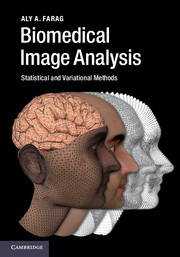Book contents
- Frontmatter
- Dedication
- Contents
- Preface
- Nomenclature
- 1 Overview of biomedical image analysis
- Part I Signals and systems, image formation, and image modality
- Part II Stochastic models
- Part III Computational geometry
- Part IV Variational approaches and level sets
- Part V Image analysis tools
- 11 Segmentation: statistical approach
- 12 Segmentation: variational approach
- 13 Basics of registration
- 14 Variational methods for shape registration
- 15 Statistical models of shape and appearance
- Index
- References
13 - Basics of registration
from Part V - Image analysis tools
Published online by Cambridge University Press: 05 November 2014
- Frontmatter
- Dedication
- Contents
- Preface
- Nomenclature
- 1 Overview of biomedical image analysis
- Part I Signals and systems, image formation, and image modality
- Part II Stochastic models
- Part III Computational geometry
- Part IV Variational approaches and level sets
- Part V Image analysis tools
- 11 Segmentation: statistical approach
- 12 Segmentation: variational approach
- 13 Basics of registration
- 14 Variational methods for shape registration
- 15 Statistical models of shape and appearance
- Index
- References
Summary
Registration is the process of relating source data to a target or model. It is a fundamental process in image analysis and machine learning. When the source and target are rigid, the process of registration involves obtaining a coordinate translation, rotation, and scaling to align the two entities. The alignment is performed according to a similarity (or dissimilarity) measure, usually involving minimization of square distance or maximizing common attributes (e.g. information content). Registration is performed for object recognition, for tracking changes and in image-guided interventions. When elasticity, or motion, is also present, the registration process takes on an extra layer of complexity. Elastic registration is used for tracking tumors, image-guided surgeries, and assessment of therapy. Some anatomical structures (e.g. heart and lungs) naturally move; hence, registration in such cases is inherently elastic. As it is common to use linearization over small spatial areas to analyze non-linear systems, elastic registration may be analyzed by successive and incremental applications of rigid registration over small regions of interest. Elastic registration may be conducted in two steps: global (rigid) registration followed by a local registration step to handle changes/deformations that the first step cannot handle. This chapter introduces the basic principles and terminology used in classic approaches for image registration.
Introduction
In general, the process of registration depends on: (1) the representation of the objects’ shapes or intensities; (2) the nature of the transformation to move the points from the experimental data (source) toward the model (target), or from model to data; and (3) a similarity/dissimilarity measure. The latter can be defined according to either the shape boundary or its entire region. This chapter addresses the basic fundamentals of registration. The following chapter is devoted to shape registration using variational models. Numerical examples will be provided for two common approaches: distance-based rigid registration using the iterated closest point (ICP) approach, and intensity-based image registration using the mutual information (MI) approach.
Information
- Type
- Chapter
- Information
- Biomedical Image AnalysisStatistical and Variational Methods, pp. 345 - 386Publisher: Cambridge University PressPrint publication year: 2014
